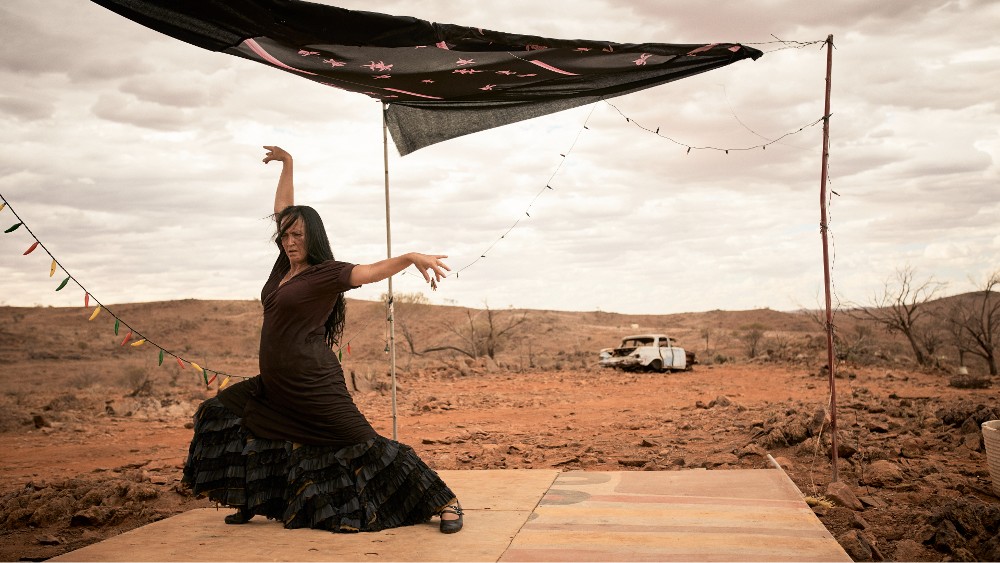Benjamin Millepied is renowned for his dance and choreography, having first come to the States from France to dance for the New York Ballet from 1995 through 2011 before running the L.A. Dance Project from 2011 through 2014 and then spending two years at the Paris Opera Ballet. In that time, he has also lent his expertise to a pair of Oscar-nominated movies — Darren Aronofsky’s Black Swan and Denis Villeneuve’s Dune.
Millepied’s resumé is good to know before seeing his feature directorial debut, Carmen, given that so much of it involves dance. Based loosely on Georges Bizet‘s opera of the same name, Carmen stars Melissa Barrera (Scream, In the Heights) as the title character, a young Mexican dancer and singer who must escape across the border after her grandmother is murdered by cartel members. During her journey, she encounters Paul Mescal’s ex-Marine Aiden, who saves her from a violent encounter with a fellow border guard and joins her on the run.
Millepied’s debut feature is quite gorgeous in every regard, from the picturesque shots of the Mexican landscape and the various dance numbers performed to its beautiful score and soundtrack, which features songs co-written by Nicholas Britell (who we’ll have a new interview with over at Below the Line fairly soon). In fact, this version of Carmen is such an artistic take that many may not even realize that the film is based on an opera.
In a rare in-person interview, Millepied sat down with Above the Line to discuss the creative vision that went into directing his first feature film, and how he landed two red-hot stars.

Above the Line: I know about your background as a choreographer and your time at the Paris Opera, but what got you started down this particular road with Carmen?
Benjamin Millepied: I think it’s two things. It’s my love for film, my interest in film. I’m not sure how many movies I watched as a kid growing up and as a young adult. And then, photography. I had a camera. I’ve been taking photos forever. It’s a desire to find atmosphere and to photograph things, and being curious about certain things and acknowledging them by photographing them. That’s the two things, and then I started to make dance films. That was really something I loved, that felt natural. Eventually, I had the dream of making [a] film. That stayed with me for years until I actually went down the road of making one, writing one, and trying to get it produced, which is a whole story.
ATL: I’ve spoken to some filmmakers who have spent a decade or more trying to get a movie made. I’m not sure how many people realize that these movies don’t just happen with the snap of a finger, normally.
Millepied: No, I had another story even that I was pitching. I always wanted an original score, and there was always this vision of a dark film with music and dance. Producers I would meet in Hollywood, would be like, ‘Well, what if we can use existing songs?’ They always wanted to corrupt that vision, which was something I wasn’t interested in. It really took me meet[ing] this French producer, who was like, ‘Okay, let’s do this. This makes sense.’
And then [they] gave me the freedom, I think, just from a French perspective of giving freedom to the director and embracing a singular vision, and not just trying to create something to entertain and make money. That was important to me because I experienced freedom in my work as a choreographer. No one tells me what to do. I go into the studio and make dance. It would have been very difficult to do this otherwise; it wasn’t some ambitious venture just to say I’m a film director.
ATL: Had you ever choreographed a version of Carmen for the stage?
Millepied: No. I was interested in Carmen, both for film and theater, and wanted to direct a version of Carmen Jones for the stage actually, which I was scheduled to direct. I didn’t do it, because it was the time that I got the Paris Opera job, so that’s what happened there.
ATL: I assume this was something you originated and were involved with from the beginning, so did you write the script yourself and bring other writers aboard?
Millepied: I had multiple writers, and some aren’t listed on this. That was the toughest part of making my first film, to understand even what the process is. With dance, it’s so instinctive, and with film, ultimately, for me, it couldn’t be just about, ‘Oh, this is a nice story… ‘ It has to have personal meaning. How do you work that out with a writer that’s not you? How do you find a writer in America to make a movie that’s not conventional and [write] dialogue that’s not on the nose with music and dance?
I was geared towards writers that were more Broadway, so things were more literal, and then nothing felt right. I understood the process as I made the movie. Now, I’m writing a second film, and it’s a completely different process because I understand much more [about] what the process of the script is and how you put yourself on the page, and how you can collaborate with a writer. It’s a much, much, much better process this time.
ATL: Do you feel comfortable sitting at a computer or a typewriter and writing in that way?
Millepied: I really don’t. What I do is that I work, like this new movie I’m writing with a writer who’s really writing all the dialogues. However, because there’s so much of it that’s a world that is mine, there’s a lot of dialogue that is mine, but that’s really based on me saying it on the fly in the work sessions, not me going at the typewriter and writing it. Maybe in a few films, but so far, I still really appreciate having somebody who’s really excellent at dialogue and letting me put something in when it’s just something I know so well that it feels completely right.
ATL: I’ve spoken to directors who write their own material, and others who just like working on set with the actors and crew and might not necessarily want to be sitting by themselves writing. Some of these filmmakers are very well known for their writing, too.
Millepied: It’s different. I think it’s whether you’re an auteur or not, and I think for me, the process of making [a] film isn’t just to find something. I have to be in it. It has to be something that resonates so personally that I have to be part of it. That’s how it is.
ATL: Was the idea always to set the story set on the border between Mexico and the United States? That’s obviously something that’s been on the news a lot in recent years, maybe not so much in France.
Millepied: I’ve actually moved back to France, but I live in L.A. That’s why it made sense, because it had to be something that was part of my life, and part of the experience of living in L.A. [is], you’re confronted with immigration. I went and visited the border and met with kids who had crossed the border.

ATL: Let’s talk about your two leads. I’m sure many people who watch this movie are going to think, ‘This guy’s a genius, casting Melissa and Paul before they really exploded.’ I’m not sure where this fell in their respective schedules, because Melissa has been in two Scream movies in the past years. Did she do this in between them?
Millepied: I think she went to do Scream after, I’m not really sure. I forget if it was before or after, but I saw her on So You Think You Can Dance? in Mexico, and she was already cast in the first season of Vida. And Paul, he was clearly the actor I needed, because I wanted someone who’s really masculine [and who] could embody that character without feeling superficial, and he really was. He had it all. He’s such a talented actor.
ATL: I was really impressed by both of them. I must’ve totally forgotten Melissa was also in In the Heights because I was taken aback by how well she could sing and dance, as well as act here. I didn’t even realize she was on So You Think You Can Dance?
Millepied: No, she was outstanding, her level of dancing is so good and free, which is what the character should embody — that freedom. [It was] really beautiful.
ATL: With your background as a choreographer, is it tougher to work with actors or musicians who aren’t natural dancers?
Millepied: I love the challenge, but I also didn’t want Paul to be too good. I wanted him to feel like a Marine who danced with her and not suddenly break into dance with this unrealistic, fluid quality. It was important, [and] that was part of it.
ATL: Let’s talk about your other collaborators, starting with Nicholas Britell, who you reached out to very early in the process, as I understand it. The music is such an important part of the movie between the songs and the dance performances, so what made you think of him?
Millepied: We were friends, and he was composing, and we just talked a lot about film and music in general, just out of [common] interest. I would share scores that I loved with him from films, and I remember sending him Hiroshima Mon Amour, the score of that, and talking about some Bernard Herrmann scores. We started to think about what would be [a] movie that would [include] music and dance. I wanted to really give him the freedom to unleash the music and not feel restrained by having his music cut and pasted and only have these small moments, to just give him a real opportunity to display his sound, which he really does in the film. The music is omnipresent
ATL: He must have written a lot of the music and songs before you even started shooting, I’d imagine.
Millepied: He wrote some of the songs and the dances before, but if you listen to the score, the choir and the strings and the synths came after. Once the movie was finished, we sat together, and he felt there was something about the movie that wasn’t right. We talked and talked and suddenly, he’s like, ‘Oh, a choir and an organ.’ Suddenly, it was there. That’s like the opening of the film, and then we applied that to the whole movie, and the choir is present the whole time. The words they sing are in French from Bizet. The words have a direct interaction with what’s happening in the scenes and what the actors are going through, so it’s almost like this choir watching the story from afar and telling the tragedy of it.
ATL: He also has that fight which is almost like a choreographed dance. When you watch a movie like this, you realize the close connections between boxing and dancing.
Millepied: Yeah, the rhythm of it, and they worked on that a lot. It was fun for me to get to shoot that scene, for sure, and to create the movement around it, and make sure that it stayed kind of brutal and real.
ATL: Who was the MC during that scene?
Millepied: “The D.O.C.“ — he’s a major rapper in the early days of California rap and [a] writer [who] had a big career and got into [a] car accident and broke his voice. He’s quite famous. He’s a great writer, he wrote for a lot of people and was very good friends with Dre. He’s actually a major guy in that scene.

ATL: One of the nicest surprises was seeing Rossy de Palma from all those great Almodóvar movies. I had just rewatched Women on the Verge of a Nervous Breakdown recently, so when she came on screen, my mouth dropped. What made you think of her for a dual role?
Millepied: It was an obvious choice, because she’s larger than life, and you needed a really bold [actor] in that part. She read it and was like, ‘I want to do this.’ There was no question around it, and she came on set and she was Masilda, she really was. She enriched the part with so many interesting details. [She’s] phenomenal.
ATL: I also want to ask about some of the craftspeople you worked with, because the costumes were beautiful, as was the production design. Was that club a real place or a space that got dressed up?
Millepied: No, it was built completely in an event space. My production designer was really amazing; everybody [was]. Australia has a real level of craft and vocation and was very, very special.
ATL: Were you able to bring on anyone you worked with on stage or in theater, or was it an all-Australian crew?
Millepied: It was really a fully Australian crew, [and a] fully Australian art department
ATL: Why did you end up filming down there?
Millepied: It was COVID. We were lucky that there was a big tax break with France, so we actually got more for our money down there. We got more days. I shot in 34 days.
ATL: It all looks amazing, and I guess there were a lot of places that you could shoot down there that can pass for Mexico and California. You didn’t shoot any of it in California at all?
Millepied: We were going to. [But] really, when I first finished the movie, I was like, ‘I didn’t need it.’
ATL: I don’t go to California often, so I can be easily fooled, I guess.
Millepied: We really were very careful. I had scouted Mexico extensively, so I really knew that I [could] make it work.
ATL: Did you have to use visual effects to do some of that?
Millepied: We added some palm trees.
Carmen is now playing in New York and L.A. and will expand to other cities over the coming weeks. Look for Below the Line’s interview with Composer Nicholas Britell sometime soon.



